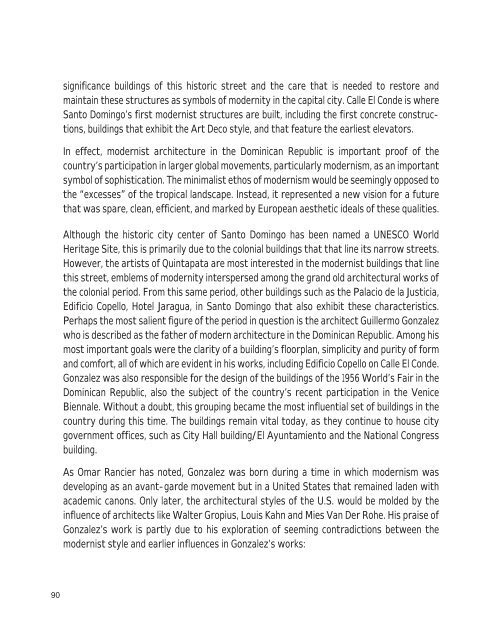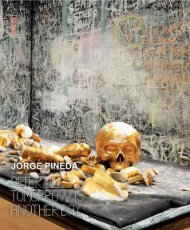CATALOGO QUINTAPATA
Create successful ePaper yourself
Turn your PDF publications into a flip-book with our unique Google optimized e-Paper software.
significance buildings of this historic street and the care that is needed to restore and<br />
maintain these structures as symbols of modernity in the capital city. Calle El Conde is where<br />
Santo Domingo’s first modernist structures are built, including the first concrete constructions,<br />
buildings that exhibit the Art Deco style, and that feature the earliest elevators.<br />
In effect, modernist architecture in the Dominican Republic is important proof of the<br />
country’s participation in larger global movements, particularly modernism, as an important<br />
symbol of sophistication. The minimalist ethos of modernism would be seemingly opposed to<br />
the “excesses” of the tropical landscape. Instead, it represented a new vision for a future<br />
that was spare, clean, efficient, and marked by European aesthetic ideals of these qualities.<br />
Although the historic city center of Santo Domingo has been named a UNESCO World<br />
Heritage Site, this is primarily due to the colonial buildings that that line its narrow streets.<br />
However, the artists of Quintapata are most interested in the modernist buildings that line<br />
this street, emblems of modernity interspersed among the grand old architectural works of<br />
the colonial period. From this same period, other buildings such as the Palacio de la Justicia,<br />
Edificio Copello, Hotel Jaragua, in Santo Domingo that also exhibit these characteristics.<br />
Perhaps the most salient figure of the period in question is the architect Guillermo Gonzalez<br />
who is described as the father of modern architecture in the Dominican Republic. Among his<br />
most important goals were the clarity of a building’s floorplan, simplicity and purity of form<br />
and comfort, all of which are evident in his works, including Edificio Copello on Calle El Conde.<br />
Gonzalez was also responsible for the design of the buildings of the 1956 World’s Fair in the<br />
Dominican Republic, also the subject of the country’s recent participation in the Venice<br />
Biennale. Without a doubt, this grouping became the most influential set of buildings in the<br />
country during this time. The buildings remain vital today, as they continue to house city<br />
government offices, such as City Hall building/El Ayuntamiento and the National Congress<br />
building.<br />
As Omar Rancier has noted, Gonzalez was born during a time in which modernism was<br />
developing as an avant-garde movement but in a United States that remained laden with<br />
academic canons. Only later, the architectural styles of the U.S. would be molded by the<br />
influence of architects like Walter Gropius, Louis Kahn and Mies Van Der Rohe. His praise of<br />
Gonzalez’s work is partly due to his exploration of seeming contradictions between the<br />
modernist style and earlier influences in Gonzalez’s works:<br />
90



